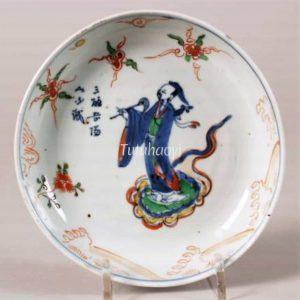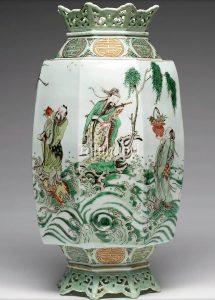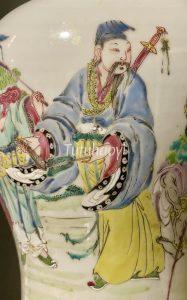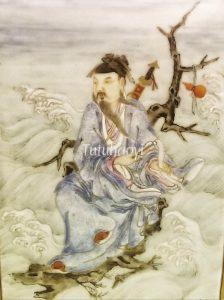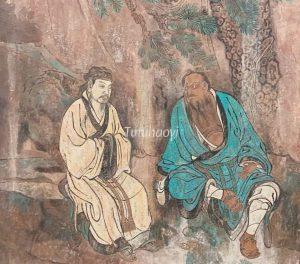Lv Dongbin
吕洞宾
© Tutuhaoyi.com owns the copyright of the description content for the images attached. Quoting all or part of the description content on this page is permitted ONLY IF ‘Tutuhaoyi.com’ is clearly acknowledged anywhere your quote is produced unless stated otherwise. (本页描述内容版权归Tutuhaoyi.com所有,转发或引用需注明 “Tutuhaoyi.com”, 侵权必究, 已注开源信息的条目除外。)
As a young man, Lv Dongbin (吕洞宾, or Lü Dongbin) passed several rounds of civil-service examinations and was twice appointed as a county magistrate. After being bored with officialdom, he went to become a recluse in the mountains. Not until he met Zhongli Quan (钟离权, or 汉钟离 Han Zhongli) in a tavern in Chang’an, did he learn the true way of the Dao from him and became an immortal. After Zhongli Quan tested him with Ten Trials, or inspired him with a dream, the teacher passed the pupil the method of concocting the Golden Pill (授以金丹之道). Both of them are famous patron saints of the Daoist discipline of neidan (内丹) or Inner Alchemy. Instead of resorting to outside substances such as minerals, the neidan adepts making the elixir within the body.
Lv Dongbin is the most colourful and popular figure amongst the Eight Daoist Immortals with many legends, plays, and pictures created for him. His prototypical portrayal is a scholar figure with a signature headdress variously named ‘chunyang jin (纯阳巾)’ or ‘huayang jin (华阳巾)’, i.e., ‘pure-yang turban’. His attribute is a practically invincible sword and sometimes a horse-hair fly whisk. He often has an acolyte accompanying him, with a miniature tree growing out of the top of his head because he was the willow spirit.
Entries and story scenes related to Lv Dongbin include the Covet Eight Daoist Immortals, the Eight Daoist Immortals, the Journey to the East, Lv Dongbin Thrice Intoxicated at the Yueyang Tower, the Story of the Blue Robe, the Story of the Luoyang Bridge, the Story of Yellow Millet, the Ten Trials, etc.
Fig 1: celadon vase (detail), Longquan ware, Yuan dynasty (1271-1368), courtesy of The Asian Art Museum of San Francisco
Fig 2: porcelain dish with underglaze blue and overglaze enamelled decoration, Kangxi period (1662-1722), Qing dynasty, courtesy of Princessehof Ceramics Museum, Leeuwarden, The Netherlands
Fig 3: porcelain lantern with overglaze enamelled decoration, Kangxi period (1662-1722), courtesy of the Walters Art Museum, Baltimore
Fig 4: porcelain vase with overglaze enamelled decoration (detail), Yongzheng period (1723-35), courtesy of Mr John Cheah’s private collection
Fig 5: porcelain vase with overglaze enamelled decoration (detail), Qianlong period (1736-95), courtesy of Shanghai Museum, China
Fig 6: porcelain incense stick holder with overglaze enamelled decoration, Zhengde period (1506-21), Ming dynasty, courtesy of Palace Museum, Beijing
Fig 7: mural (detail), Zhongli Quan and Lv Dongbin Discussing the Dao, on the wall of the Hall of Pure Yang (纯阳殿), Eternal Joy Temple (永乐宫), Shanxi province
Fig 8: album leaf, Eight immortals from the album Immortals and Children, ink and colours on silk, Wang Zhongqian (?-?), Qing dynasty (1644-1911), courtesy of the National Palace Museum, Taipei
